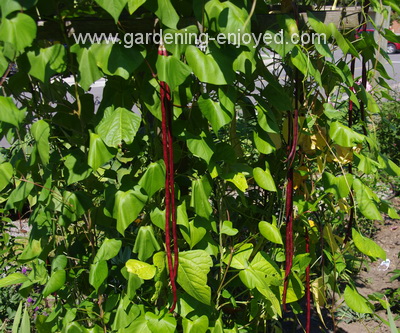| Back to Back Issues Page |
 |
|
Dallying In The Dirt, Issue #326 - These amazing long red beans just appeared in my garden September 01, 2018 |
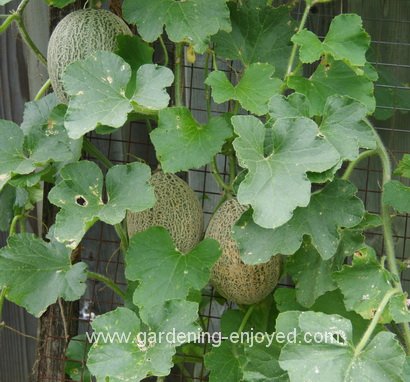 One of this years experiments in the vegetable garden was growing melons in the subirrigation containers. We have enjoyed a couple of Minnesota Midgets and are looking forward to these beauties becoming ripe. That, of course, always opens the debate about knowing when a melon is ripe. Lots of looking, feeling for softness, tapping to hear the sound and checking the tendril that grows at the point of attachment of the Melon. When that tendril turns brown the Melon is supposed to be ripe. The two we have eaten, from the adjacent container were ripe, sweet, juicy and delicious. Growing them up the wire frame has kept the fruit off the ground so that it doesn’t get any slug holes or soft spots from contact with the soil. That wire frame was positioned just behind the subirrigation container and the vines were directed to it at an early stage and they climbed it happily. The vines seem to be strong
enough to support the Melons hanging from it but I don’t think I would try this technique with Watermelon. The anticipation is as delightful as the realization will be.
One of this years experiments in the vegetable garden was growing melons in the subirrigation containers. We have enjoyed a couple of Minnesota Midgets and are looking forward to these beauties becoming ripe. That, of course, always opens the debate about knowing when a melon is ripe. Lots of looking, feeling for softness, tapping to hear the sound and checking the tendril that grows at the point of attachment of the Melon. When that tendril turns brown the Melon is supposed to be ripe. The two we have eaten, from the adjacent container were ripe, sweet, juicy and delicious. Growing them up the wire frame has kept the fruit off the ground so that it doesn’t get any slug holes or soft spots from contact with the soil. That wire frame was positioned just behind the subirrigation container and the vines were directed to it at an early stage and they climbed it happily. The vines seem to be strong
enough to support the Melons hanging from it but I don’t think I would try this technique with Watermelon. The anticipation is as delightful as the realization will be.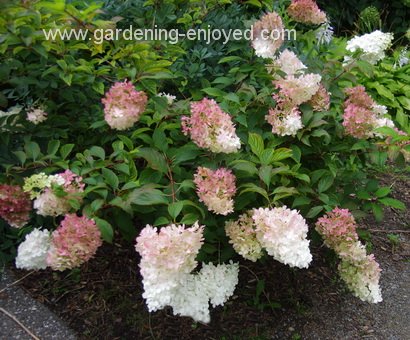 Plant breeders have been producing new Hydrangeas at a great rate for the past few years and I have planted many of them. Very few of the Hydrangea macrophylla have been successful in my garden. They grow beautifully but rarely flower. This past winter they all were killed to the ground and most have regrown with lovely foliage but, again, no flowers. The paniculata types are just the opposite. Despite being much larger their above ground parts seem to survive the winters with very little die back and then they produce these lovely cone shaped flower heads. They all start out white but many of the new varieties quickly develop this rich pink colour and then these two tone flower heads persist for several weeks. You can cut them and bring them indoors and let them dry and they will last for months gradually losing their colour. This one has a bush form that cascades and the one around the corner has been trained into a small tree. I have a couple that seem to remain
white and they came to me as small starter plants and they are in the propagation bed where I am training them into standards. They are about 75 cm tall now and I think I will move them out front this fall. Of course I have lost the name of the one in the picture but there are several varieties on the market they are quite similar.
Plant breeders have been producing new Hydrangeas at a great rate for the past few years and I have planted many of them. Very few of the Hydrangea macrophylla have been successful in my garden. They grow beautifully but rarely flower. This past winter they all were killed to the ground and most have regrown with lovely foliage but, again, no flowers. The paniculata types are just the opposite. Despite being much larger their above ground parts seem to survive the winters with very little die back and then they produce these lovely cone shaped flower heads. They all start out white but many of the new varieties quickly develop this rich pink colour and then these two tone flower heads persist for several weeks. You can cut them and bring them indoors and let them dry and they will last for months gradually losing their colour. This one has a bush form that cascades and the one around the corner has been trained into a small tree. I have a couple that seem to remain
white and they came to me as small starter plants and they are in the propagation bed where I am training them into standards. They are about 75 cm tall now and I think I will move them out front this fall. Of course I have lost the name of the one in the picture but there are several varieties on the market they are quite similar.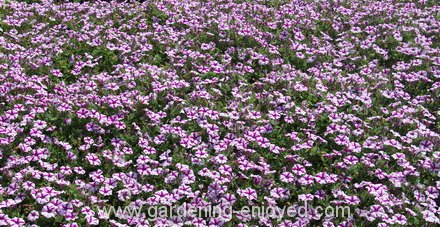 Last week I spent a day at the U. of Guelph’s trial gardens looking at turf trials and new varieties of annual flowers. Guelph runs a test garden and it’s always interesting to see the new varieties and the comparison plants they are trialled with. I’m not usually a big fan of Petunias but many of the new varieties are slowly converting me. This is a hybrid called Supertunia Lovie Dovie. The Supertunias are vegetatively propagated which means that we seed starters have to buy the plants in the spring as there is no seed available. They can look great in containers but also do very well as garden plants as they are in the picture. Lovie Dovie has interesting white and pink bicolour flowers and a rapid but compact growth habit. It stood out for me from most of its neighbours because of the solid mass of colour and the extent of its spread.
Last week I spent a day at the U. of Guelph’s trial gardens looking at turf trials and new varieties of annual flowers. Guelph runs a test garden and it’s always interesting to see the new varieties and the comparison plants they are trialled with. I’m not usually a big fan of Petunias but many of the new varieties are slowly converting me. This is a hybrid called Supertunia Lovie Dovie. The Supertunias are vegetatively propagated which means that we seed starters have to buy the plants in the spring as there is no seed available. They can look great in containers but also do very well as garden plants as they are in the picture. Lovie Dovie has interesting white and pink bicolour flowers and a rapid but compact growth habit. It stood out for me from most of its neighbours because of the solid mass of colour and the extent of its spread.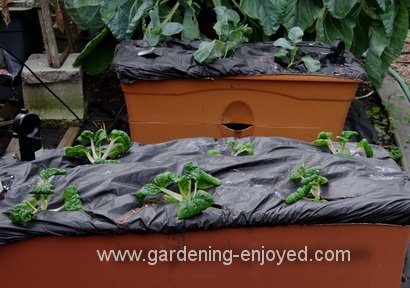 It’s the first of September and I’m hiding in my office from the heat and humidity and abut to tell you about planting my cool season vegetables in the great hope that they will survive this heat and actually get to grow in some cool weather. It has been a very hot summer and I’m tired of spending my hours in the garden trying to find a shady spot. They are easy to spot, they are the areas with the fewest weeds because it’s where I’ve spent the most time. The subirrigation containers have all been replanted with the seedlings that had moved up to the table on the deck from the lights in the basement. Kohl Rabi, Cauliflower 3 types, Cabbage, Pak Choi, Fennel and the rest are now struggling to find the moist soil in those containers as the heat sucks water from their leaves faster than their disturbed roots can find and replace it. They
should grow and feed us happily until at least the end of October. There’s another whole technique to keep crops growing throughout the winter in various types of cover but I have to confess I just want to have a break from the garden and go skiing.
It’s the first of September and I’m hiding in my office from the heat and humidity and abut to tell you about planting my cool season vegetables in the great hope that they will survive this heat and actually get to grow in some cool weather. It has been a very hot summer and I’m tired of spending my hours in the garden trying to find a shady spot. They are easy to spot, they are the areas with the fewest weeds because it’s where I’ve spent the most time. The subirrigation containers have all been replanted with the seedlings that had moved up to the table on the deck from the lights in the basement. Kohl Rabi, Cauliflower 3 types, Cabbage, Pak Choi, Fennel and the rest are now struggling to find the moist soil in those containers as the heat sucks water from their leaves faster than their disturbed roots can find and replace it. They
should grow and feed us happily until at least the end of October. There’s another whole technique to keep crops growing throughout the winter in various types of cover but I have to confess I just want to have a break from the garden and go skiing.Because it is the first of September my thoughts look ahead to my calendar where the list of my speaking engagements continues to grow. Many of my readers are responsible for booking speakers for their various organizations and they start to turn their minds to such tasks at this time of year. I thoroughly enjoy my speaking engagements and all the people I get to meet through that activity. If you have had me speak before then you might want to look at some of my other topics that are outlined here. If you are looking for a particular topic that you don’t see then contact me as I can probably create the talk that you are looking for. It’s difficult to
blow one’s own horn but it seems that I am a very engaging speaker with a wealth of knowledge and a healthy sprinkling of entertainment mixed in. There are still some spaces for this fall and it’s certainly not too early to book for next winter and spring. I would love to hear from you. Now it’s time to answer a few of my reader’s questions. To ask a question just “reply” to this ezine. Don’t forget to check the front page of the Website for frequent short ideas for current gardening activities. Donna Asks? My peonies have a white chalkie substance on their leaves. These are 5 year old plants and produce lovely blooms but lat year had this blight or whatever and now again this year. Should I cut the bush down, or treat this chalk mess or just ignore it. |
| Back to Back Issues Page |
